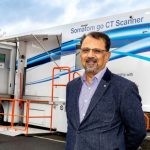Our latest featured interview is with Robert Miller, CEO of Wellbeing Software/Citadel Health. Robert joined us to discuss imaging with a focus on how connected radiology is working across consortia, challenges and results from customer projects, and the imaging improvements he would like to see in the future.
On the organisation and his role
In the UK the Wellbeing Software division covers radiology, maternity, eConsent and data management services, but we’ve got a fast-growing presence in the UK pathology market as well, winning major contracts like the NHS Wales all-of-country LIMS and the NHS Scotland national laboratory medicine framework.
Another key element of Wellbeing Software is our connected marketplace, AI Connect – it’s a vendor-neutral gateway into the NHS, working with our own radiology information system and other third-party systems. We are a leading provider of radiology information systems to the NHS, and because we are already serving more than 70 percent of trusts, it’s a straightforward way that AI can be incorporated into existing radiology workflows. This gives healthcare organisations a simple route to radiology AI adoption, while also giving AI providers an avenue to become embedded within existing workflows.
The more we can do with AI to help to reduce the amount of reporting required by the consultants, the more we can improve the throughput and turnaround times. The improvements will continue to be delivered to the patients, but as patients we are always demanding of our healthcare providers because our health matters so much to us all.
In terms of my own career, I’ve worked with several healthcare IT companies, across areas such as clinical natural language processing and electronic medical record suppliers. Some have been UK-based companies, others have had their headquarters in the US and also Australia, so I’ve worked with a variety of different sizes and shapes of organisation. I joined Wellbeing Software in March this year to head up the UK Health Division of Citadel Health, the health arm of the Citadel Group, which acquired Wellbeing Software in 2020.
Connected radiology working across consortia
Imaging has progressed a lot over the years. Initially we were working with X-rays, now we have digital imaging – so it’s now about managing best practice and workflow, and managing the support processes for the radiologists and radiographers.
From a radiology perspective, there’s still a lot of focus on the reporting, vetting, and information being supplied back into the final report; it just happens to be through a digital mechanism now, so you’re no longer delayed by waiting for the physical X-ray to come through. Digital images allow the reporting to be done from anywhere, and more and more the workflow is being distributed right across organisations and trusts. There’s no reason why an image has to be reported in the same location that it was taken.
With a lack of radiologists and radiographers in the workforce at present, reorganising and reusing resources across organisations becomes invaluable. The fact that the process is now digital means that resources can be more easily shared. It also allows more use of external teleradiology organisations, so that they can support the higher volume requirements that are a challenge for the NHS.
Ultimately, it allows information to be shared much faster and provides for a better patient experience, so being able to speed up that process is valuable from both a clinical and patient perspective.
Working with the SWASH consortium
We’re working with the SWASH consortium, which includes Portsmouth Hospitals NHS Trust, Isle of Wight NHS Trust, Salisbury NHS Foundation Trust, Southern Health NHS Foundation Trust and University Hospital Southampton NHS Foundation Trust.
Across those member trusts, almost two million patient exams are managed each year. They realised that they had a limited ability to access or share information beyond particular locations or teams, so turned to our technology to address the growing pressures on their radiology services by creating an accessible imaging network.
The main thing radiologists are looking for is to try and make their workflow much more efficient. The huge challenge for the clinicians on the wards is to have all the information in front of them, organised in a way that really facilitates patient care. This is where our CRIS Radiology Information System has come in – they’ve got higher and higher volumes to process, so it’s obviously far better to be able to share resources, and report and result digitally. So ultimately all that information is being shared across the various systems, irrespective of the system that captures the image.
CRIS is helping connect teams and patient information across the consortium, accelerating the workflow from referral to vetting to treatment via the web-based radiology information system, accessible from anywhere. When they’re not having to spend all this time chasing down information, they can put that time directly into patient care.
We’re also helping to streamline internal referrals and cut repeat scans, improving external communication with patients as well. Access becomes better and the faster reporting turnaround times help everyone. We respond directly to their particular challenges and provide the enabling technologies, allowing them to be able to share valuable resources and workflows.
Challenges facing imaging
One of the biggest challenges is that there are some specialist resources that are incredibly scarce. Rather than each organisation having that skillset – which isn’t affordable and probably not even feasible in some areas – we need that ability for information to be shared and data to flow to where the individual is located.
The fact that something can be reported from anywhere at any point in time is a big benefit; however there remains a question for the trusts around what organisational changes they need to make that more effective.
One of positive impacts of COVID was the requirement to remove some bottlenecks within the system and to enable a more streamlined process. Technology enables some aspects of this, but obviously organisations also have to reorganise and have the appropriate processes, resources and controls in place to support the technology. Previously physical and technological constraints placed restrictions on the NHS being able to share that workload. Now that organisations have the ability to share and report from anywhere, they are better placed to consider the next stage of service transformation.
Through this, I believe we are well placed to help solve the current problems related to turnaround times, waiting lists, and the backlogs that have built up during COVID.
Looking to the future: imaging in five years
If I look at the NHS, I think the sharing of information is still in its infancy, and we are still at an early stage from an analytics perspective. The NHS is targeted on curative rather than preventative healthcare, however the more data we can access, the greater our ability will be to move towards personalised and preventative medicine. The other important factor that we’re seeing –again COVID enforced– is that many healthcare services we historically believed couldn’t be done anywhere other than within a hospital environment suddenly had to be done in another manner. This has resulted in greater investment to provide services remotely and locally in community settings.
So going forward, you don’t necessarily need to be going into a hospital. Patients can have access to a wider range of services provided from alternative locations and reported from anywhere. More and more hospitals are investing in local facilities to be able to provide those services locally within the community, particularly in some of the more rural parts of the country. There is still a big difference between being based in Edinburgh, Glasgow, London or Birmingham, as opposed to being based in some of the rural communities – pushing this out into those communities allows that same information to be reported by the same specialist somewhere else in the country. From a patient care perspective, the provision of local services and rapid access to results provides a real opportunity for greater equality and an improved patient experience.
There is also a strong drive towards integrated diagnostics services. That’s partly due to facilities being able to provide those services away from the core hospital services, but it also signals a change in thinking around the value of the data. In addition, the ever-increasing use of artificial intelligence within diagnostics has the potential to significantly reduce reporting times and workload through the provision of clinical decision support. It will never replace the clinician, but it does offer another valuable addition to the toolkit.
Many thanks to Robert for his time.





